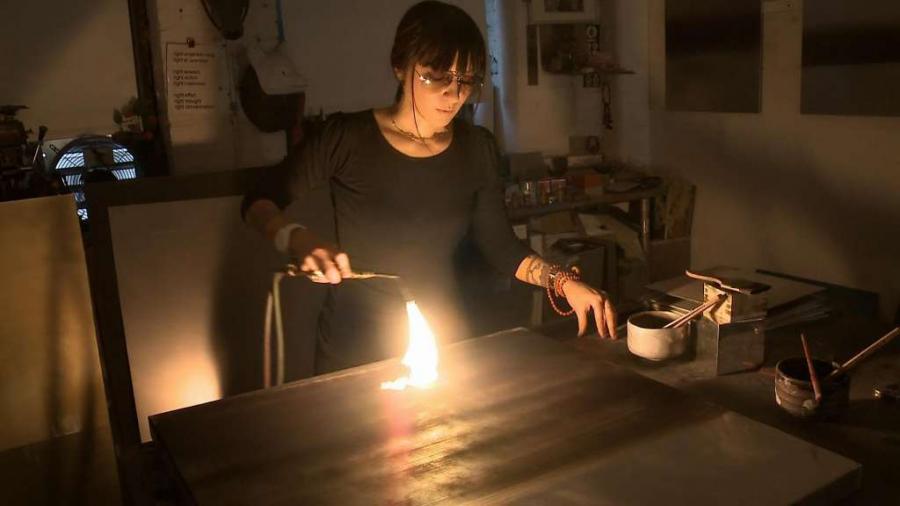Miya Ando’s art influenced by heritage, ancestry
by Jessica Zack
It’s hard to think of a family lineage and childhood circumstances that could have better prepared artist Miya Ando for her career as an artist, working with the light-reflecting properties of metal to create nuanced paintings renowned for encouraging viewers’ mindfulness and tranquillity.
The daughter of a Japanese mother and Russian American father, Ando grew up bilingual and deeply connected to nature and Buddhist practice. Before engaging in East Asian studies at UC Berkeley, Ando split her time as a child between a “very much off-the-grid” home on 25 acres deep in the Santa Cruz Mountains and a small Nichiren Buddhist temple in Okayama, Japan, where her grandfather was the head priest.
“I became interested in metal from a very young age, aware of this true mythology of being descended from swordsmiths,” says Ando, one of whose maternal ancestors is the famous Bizen sword maker Ando Yoshiko Masakatsu, “whose sword is a national treasure in Japan.”
So it is fitting that Ando has developed an artistic practice that blends experimental metalworking with a reverence for the beauty of natural phenomena and ideas of impermanence and mutability. In her solo exhibition, “Atmosphere,” at Nancy Toomey Fine Art in the new Minnesota Street Project, Ando displays the results of her pioneering technique of weaving pure silver fibers into gossamer fabric, as well as ethereal paintings on stainless steel and silver-nitrate-coated wood.
Ando achieves subtle gradients of color and striated texture on her metal canvases through the repetitive, physically demanding work of applying fire and chemicals, and by sanding, polishing, grinding and oxidizing patinas to alter the material’s appearance and chemical structure.
“I’m interested in the transformation of surfaces and the idea that an element can take different forms,” said Ando by phone from her studio in Long Island City, where she has worked since relocating from San Francisco to New York in 2006. “It is a reminder that time, like light, is fleeting.”
After a 2002 apprenticeship with a master metalsmith in Japan, Ando says, she “walked away with a great appreciation for the fact that materials have a nature.”
“Wood has its grain, which reveals its age and chronology. Metal redirects light to an incomparable degree and has the ability to shift with its conditions,” she says.
Because of her materials’ attributes, “my artwork is all experiential,” she adds. “The paintings change depending on light conditions and are like a barometer of the day. I hope they encourage people to linger, to be aware and take notice of their environment.”
Ando’s imagery may suggest foggy skies, yet she says it is up to each viewer whether they see a horizon line, or instead a color-field abstraction. “Richard Diebenkorn said he liked to paint in the middle place, right between abstraction and landscape, and I really like that middle place as well,” she says.
Exhibition curator Michelle Bello has championed Ando’s work ever since the artist, who now has an international following, worked out of a studio in the Hunters Point Shipyard more than a decade ago.
“Evoking the natural world, Miya’s work begs us to slow down,” Bello says, “to notice how it shifts in the light or changes as you walk past it.”
